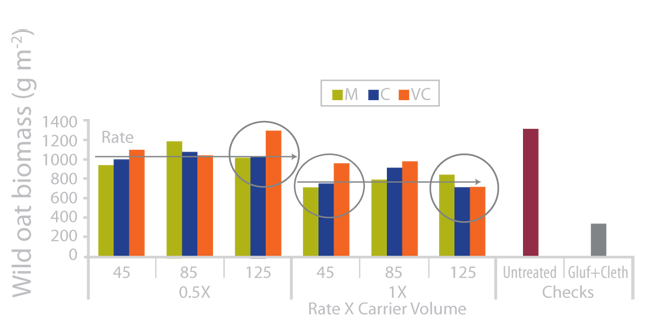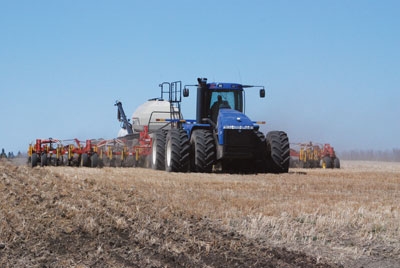
Features
Agronomy
Weeds
Wild oat control in Liberty Link canola
Wild oat control in Liberty Link canola can be a challenge with Liberty (glufosinate) herbicide. As a contact herbicide, glufosinate requires good coverage for adequate control. A recent Agriculture and Agri-Food Canada (AAFC) research study found that using good agronomics is much more important than spray quality.
“Because of the vertical growth nature of wild oat, it is hard to hit with a herbicide,” says Eric Johnson, research scientist with AAFC at Scott, Saskatchewan. “Spray quality doesn’t matter so much with herbicides that translocate, but a contact herbicide like glufosinate requires good coverage for control.”
Johnson and AAFC colleague Tom Wolf at Saskatoon looked at crop management, glufosinate rate and spray quality to see if wild oat weed control could be improved. Their three-year study from 2007 to 2009 was funded by SaskCanola, and was part of a larger canola inputs study conducted by Stewart Brandt, retired AAFC research scientist.
Previous research had found that glufosinate wild oat control is sensitive to low water volumes and very coarse spray quality. Yet farmers and custom applicators are looking for these very characteristics to improve efficiencies and reduce herbicide drift – low water volumes and coarse sprays. Johnson wanted to see if crop management factors could overcome the limitations of low water volumes, coarse sprays and reduced herbicide rates.
The study looked at the interaction of different factors and their influence on wild oat weed control. All were compared to an untreated check.
- Crop management:
• Full inputs: Hybrid canola (9590 LL) seeded at 150 seeds per square metre with fertility applied to attain a 1950 kilograms per hectare target yield
• Low inputs: OP canola (75P00 LL) seeded at 75 seeds per square metre with half fertility applied to attain target yield - Liberty rate
• 1X rate (1.08 litre per acre) and 0.5X - Spray quality
• Medium, coarse, very coarse - Carrier volume
• 45, 85, 125 litres per hectare (4.5, 8.5, 12.5 gallons per acre) - A glufosinate and clethodim (Select herbicide) tank-mix applied in 100 litres per acre with medium spray quality

Manage the crop well – then sweat the little stuff
Crop management had the largest impact on wild oat control. Crop management (full inputs) was responsible for a 32 percent weed biomass reduction; the use of glufosinate, 24 percent; spray quality, 10 percent (but no effect at full rate and high water volume); and water volume, 16 percent (but only at full rate). As it relates to yield, crop management was responsible for 72 percent of the yield improvement in canola.
Of the herbicide application parameters, rate had the largest effect on wild oat control with the 1X rate providing the best control. At the one-half glufosinate rate, going very coarse even at the highest water volume resulted in significantly higher weed biomass than coarse and medium.
“The worst thing you can do is cut rate and go real coarse,” notes Johnson. “In other words, you can’t improve performance of a lower rate of glufosinate by increasing water volume.”
At 1X rate of glufosinate at lowest water volume, a very coarse spray resulted in significantly higher weed biomass than medium and coarse. However, increasing water volume overcame problems with very coarse spray at the full rate of glufosinate. Johnson says if you lower water volumes at full rate, a finer spray quality may be required.
Johnson points out that the 1X (1.08 litre per acre) rate used in the study is slightly below the current rate of 1.35 litre per acre recommended for wild oat control. Bayer CropScience changed its recommended label rate soon after the study was started; however, it is not thought that the lower rate used makes a huge difference in terms of the study results and their interpretation.

The study also found that the clethodim tank mix was required to minimize weed biomass and maximize yield. When this tank mix was included in the full-input package, it increased yield by 44 percent over the low-input package.
In terms of canola yield, the overall results found that crop management was most important followed by glufosinate rate, carrier volume and spray quality. With recommended glufosinate rates, application parameters such as spray quality and water volume had less impact on weed biomass and canola yield.
“A lot of farmers spend a lot of time on nozzle selection and controllers, but the first thing they should be doing is paying attention to good agronomics,” says Johnson. “Application parameters should just be considered fine-tuning of weed control.”
March 26, 2013 By Bruce Barker
 High seeding rate of a hybrid canola with good fertility provided a 72 percent yield improvement. Wild oat control in Liberty Link canola can be a challenge with Liberty (glufosinate) herbicide.
High seeding rate of a hybrid canola with good fertility provided a 72 percent yield improvement. Wild oat control in Liberty Link canola can be a challenge with Liberty (glufosinate) herbicide.